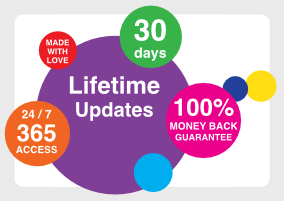Symbiotic Design 101
NOW Available!
Consider making a donation.
Course Description
This introductory course is a theoretical sweep of the fundamentals that support the framework and some simple tools are provided for implementing the Symbiotic Design Framework SDF into your design projects. Ethics, Sustainability, Social impact and Economics are the foundations on which the framework has been constructed. Autopoiesis, Systems Theory and Symbiosis are the tools used to reconfigure the way we see and understand Design. And Design’s legacy is the cocktail mix used to brew the framework. SDF is a more ambitious artifact than the contents seen in this course, but even so, after taking Symbiotic Design 101 you will no longer be able to design and see Design as before. And we guarantee you that.
Why you should enroll?
Enroll to learn why doing the right questions, learning about critical thinking and questioning your problem solving skills, will ultimately change the way you think about design. Once you achieve critical thinking, you will stand out above your peers, as the person to go to on Ethical, Sustainable, Social and Economical issues.
What will you achieve
You will overview the world of design, systems thinking, autopoiesis, and symbiosis. By understanding design as an interconnected and self-organizing discipline, you will be able to make more informed and environmentally friendly decisions. Dive into the fascinating world of Symbiotic Design 101, an introductory course that promises to revolutionize your design thinking. You will:
Uncover the urgent need for a paradigm shift in design.
Realize the ethical, environmental, social, and economic imperatives that demand change.
Acknowledge the sad truth - traditional design has fallen short in sustainability for the past two centuries.
Discover the foundations of the Symbiotic Design Framework.
Unearth the theories behind it and understand why Autopoiesis, Systems Theory, and Symbiosis are critical for sustainable design.
Challenge the status quo and appreciate the importance of a singular framework over multiple models.
Witness the unveiling of a novel framework that will disrupt your conventional way of working.
Transition from linear or circular models to a nonlinear, dynamic approach.
Examine the four cornerstones, the mottos, and their relation to the United Nations Sustainability Goals.
Demystify the design components and their interrelations.
Grasp how to navigate this complex landscape with the aid of a Symbiotic Design worksheet.
Learn to ask the eight most important questions to achieve true sustainability.
Embark on this journey and start making your design outcomes more sustainable from day one.
Explore what lies beyond this introductory course.
Who is this course for?
Junior or experienced designers with an interest in sustainability will benefit from this course. Even if you have taken sustainability courses before, this course will introduce you to a new paradigm. It will confront you with questions you never wanted to face before. This opportunity is for those who are really thinking and willing to make a change. The Academy offers a plethora of courses in Symbiotic Design related issues. If you dare to delve deeper, prepare to become an expert in tackling complex, wicked problems from a design perspective.

When you enroll in any of our Courses, Bundles or TRACK you also get:
All of our students earn certificates of completion. They come with a verification code.
We’ve got you covered. If something doesn’t come out as you expected, contact us. If we can’t fix it, we will honor our promises.
Gonzalo Raineri Phd is your instructor. Over 35 years of professional experience as a Designer and Architect, 25 years as a university professors. Theory and practice developed side by side.
Students Testimonials
-

-

I was really impressed by the comprehensive approach that the Symbiotic Design Academy is teaching. Although the amount of information is immense, it is presented in a very clear format with a succinct framework to follow.
-

Enriching learning experience! The course, though challenging, provided valuable insights into design thinking. The interactive elements kept me engaged. Overall, it is a rewarding journey for those seeking a deeper understanding of design principles.
Valeria Valdivia
HR Officer at Concern Worldwide | MA HR Management | BHRM | Assoc CIPD qualified
Dublin, Ireland
Course Content
Welcome
-
Welcome form the instructor and a general view of the contents of the course are presented
The Why
-
Humanity has lost perspective of its surroundings and we have forgotten all necessary relations for a harmonious coexistence with other species. We must change the way we have been doing things, and the Symbiotic Design Framework will helps us collectively to do so.
5:45
-
The Anthropocene is a man made phenomena that is causing a global geological change. This is impacting the planet's climate and ecosystems, taking us all to a massive biodiversity extinction.
Designers have been part of it. It’s time to change.
3:57
-
Wicked problems are wicked to explain and they are extremely difficult to manage and “solve”. Due to their nature they are an ever evolving phenomena, and to address them we need dynamic approaches like the Symbiotic Design Framework
3:22
-
Anthropocene, social inequalities and other misfortunes have proven that the way we have been teaching Design is not working. We need new approaches embedded into our educational systems for us to be at the same level as the circumstances we are confronting.
1:59
The What
-
Good designers, really good designers, when confronted with a challenge, never give answers, they make questions. If you’re not researching, you are doing Pseudo Design.
3:00
-
If Autopoiesis has worked in nature for so long, shouldn’t we as a collective start applying it into our Design outcomes?
6:54
-
Systems theories and Symbiosis are the other two key concepts we need to master for a proper appropriation of the Symbiotic Design Framework.
5:09
-
Models are all lineal, frameworks introduce nonlinear and dynamism onto our workflows.
4:06
-
Frameworks are the structures underlying a system. A structure is composed of components and the way they are organized and Design is a system on itself. It’s a social construct based on explicit or tacit agreements by the collective of designers.
2:52
-
Download this diagram before proceeding.
The How
-
The Symbiotic Design Framework has been configured based upon Design’s legacy and as such it has the capability of embracing Design’s past, present and future variations.
6:07
-
If we can explain our past through the frameworks perspective, we understand its importance for our future outcomes.
2:42
-
As soon as we understand and accept that Design has frontiers, has disciplinary limits, we can realize that many of the things we have being doing are not Design. Not better, not worse… just different.
5:09
-
Ethics, Sustainability , Social and Economics are the four Mottos on which the frameworks stands. Without them we would have no light at the end of the tunnel.
4:47
-
These eight components must be present on all Design projects if you are expecting to make your Design outcomes sustainable ones. If one is missing, you won’t achieve sustainability and certainly you will not be doing Design. Maybe something creative, but definitely not Design.
12:03
-
As important as Components, the relations we establish amongst them will determine the kind of impact our actions as Designers do in our environments.
7:03
-
Implementing the Framework is easy when you use your worksheet. We will explain you in a few minutes how to change your outcomes.
12:23
What’s Next
-
It is time to move on. Find out what the future holds for you.
3:40
-
Design is a collective endeavour and as such we need your input to make this and future courses better for you and the environment.






